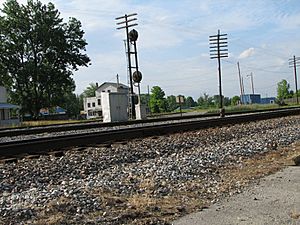Lebanon Junction, Kentucky facts for kids
Quick facts for kids
Lebanon Junction, Kentucky
|
|
|---|---|

Location of Lebanon Junction in Bullitt County, Kentucky.
|
|
| Country | United States |
| State | Kentucky |
| County | Bullitt |
| Incorporated | 1895 |
| Named for | its position on the L&N railroad |
| Area | |
| • Total | 5.74 sq mi (14.87 km2) |
| • Land | 5.64 sq mi (14.61 km2) |
| • Water | 0.10 sq mi (0.25 km2) |
| Elevation | 532 ft (162 m) |
| Population
(2020)
|
|
| • Total | 1,746 |
| • Estimate
(2022)
|
1,778 |
| • Density | 309.46/sq mi (119.49/km2) |
| Time zone | UTC-5 (Eastern (EST)) |
| • Summer (DST) | UTC-4 (EDT) |
| ZIP code |
40150
|
| Area code(s) | 502 |
| FIPS code | 21-44362 |
| GNIS feature ID | 2404904 |
Lebanon Junction is a small city in Bullitt County, Kentucky, in the United States. It's known as a "home rule-class city," which means it has the power to manage its own local affairs. In 2020, about 1,746 people lived there.
Contents
Where is Lebanon Junction?
Lebanon Junction is located in the southern part of Bullitt County. It sits near the southeastern edge of Fort Knox, a famous U.S. Army base.
The major highway, Interstate 65, runs right through the city. This makes it easy to get to other places. For example, it's about 13 miles north to Shepherdsville, which is the county seat. You can also reach downtown Louisville by driving about 32 miles north on I-65. If you head southwest on I-65 for about 14 miles, you'll get to Elizabethtown.
The Rolling Fork river forms the southwestern border of the city. This river also acts as the county line, with Hardin County on the other side. To the south, across Wilson Creek, is Nelson County.
The city covers an area of about 5.7 square miles (14.9 square kilometers). Most of this area is land, with a small part being water.
A Look Back: Lebanon Junction's History
Lebanon Junction started because of the Louisville and Nashville Railroad. This railroad had a special switching point here. It allowed trains to split off the main line and go onto the Lebanon Branch, which ended in Lebanon, Kentucky. This branch was finished by 1858. The town grew because railroad workers were needed to manage the train station and switching area.
The city of Lebanon Junction officially became a city on April 1, 1895. About 700 people lived there at first. The town grew and did well until May 24, 1912. On that day, a big fire swept through the business area, destroying many shops and homes. But this didn't stop the town! By the end of 1912, the business section was rebuilt and even better than before.
The town kept growing. In 1931, a school for grades 1 through 12 was built. This school was a very important place for the town's activities. People would often gather in the gymnasium, which was rebuilt in 1938 after the great flood of 1937, to watch basketball games. The school even had a six-man football team.
Lebanon Junction was also home to the first private Catholic school in Bullitt County. Father Harold Ritter started the St. Benedict School in 1948. It taught students from grades 1 to 12 from 1949 to 1965. After that, it focused on grades 1 to 8 until it closed in 2001.
Growth slowed down in the 1930s because of the Great Depression. Also, the railroad started moving its main operations to yards in southern Louisville. This, along with fewer people using commuter trains and new technologies like diesel engines, made the railroad less important to the town.
Throughout its history, Lebanon Junction has faced floods from the Rolling Fork river. Major floods happened in 1937, 1961, 1964, 1978, 1989, and 1997. After the 1997 flood, new levees (walls to hold back water) were built to protect the town.
Despite these challenges, the town has kept going strong. Today, its economy is mostly based on its easy access to Interstate 65. Most new businesses are located near the highway exit. In the 1980s, a gas station and a large truck stop were built. In 1990, Publisher's Printing Company opened a big printing factory near the exit.
More recently, the town has seen new wastewater treatment areas and a new public library. The library, finished in 2010, even has a design that reminds people of the town's railroad history.
People in Lebanon Junction
| Historical population | |||
|---|---|---|---|
| Census | Pop. | %± | |
| 1880 | 116 | — | |
| 1900 | 599 | — | |
| 1910 | 807 | 34.7% | |
| 1920 | 882 | 9.3% | |
| 1930 | 1,267 | 43.7% | |
| 1940 | 1,141 | −9.9% | |
| 1950 | 1,243 | 8.9% | |
| 1960 | 1,527 | 22.8% | |
| 1970 | 1,571 | 2.9% | |
| 1980 | 1,581 | 0.6% | |
| 1990 | 1,741 | 10.1% | |
| 2000 | 1,801 | 3.4% | |
| 2010 | 1,813 | 0.7% | |
| 2020 | 1,746 | −3.7% | |
| 2022 (est.) | 1,778 | −1.9% | |
| U.S. Decennial Census | |||
In 2000, there were 1,801 people living in Lebanon Junction. Most of the people were White. There were also small numbers of African American, Native American, Asian, and people of two or more races. About 0.61% of the population was Hispanic or Latino.
The average household had about 2.5 people, and the average family had about 3 people. About 26% of the population was under 18 years old. The median age in the city was 37 years.
Schools and Learning
Today, Lebanon Junction has one public school: Lebanon Junction Elementary School, which teaches students from kindergarten to 5th grade.
For middle school (grades 6–8), students go to Bernheim Middle School. This school is located near Interstate 65 at exit 112. High school students attend Bullitt Central High School in Shepherdsville, which is east of exit 117 on I-65.
The town also has a public library. It's a branch of the Bullitt County Public Library system, offering books and resources for everyone in the community.
See also
 In Spanish: Lebanon Junction (Kentucky) para niños
In Spanish: Lebanon Junction (Kentucky) para niños


